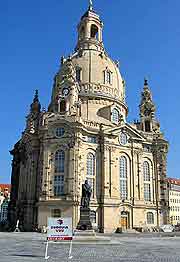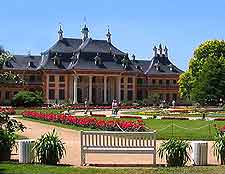Dresden History Facts and Timeline
(Dresden, Saxony, Germany)

The roots of Dresden's history are thought to be Slavic in origin. As early as 7,000 BC, the area was a place of settlement by Neolithic tribes.
One of the earliest mentions of the city in historical records dates to 1206, when it was noted as being a fording point over the River Elbe. Settlements existed on both sides of the river, which became known as Antiqua Dresdin and then Altendresden. When translated, this simply means 'Old Dresden'.
From the Middle Ages On
Dresden's rise to prominence came relatively late in the Middle Ages. In 1423, the ruler of Saxony was made an elector of the Holy Roman Empire. However, it wasn't until 1485 that the electors made the city their main place of residence.
The late 17th century and first half of the 18th century was something of a 'golden age' for Dresden, both in terms of its magnificent art and its architecture. This was a time when its two electors also served as kings of Poland and, thus, controlled a huge empire. The first of the Polish monarchs was Augustus I, also known as Augustus the Strong. He was said to have gathered together in Dresden many fine musicians, artists, planners and builders.
In 1806, the Holy Roman Empire was dissolved as a consequence of the Napoleonic Wars. The city became an important base for the French Emperor. Later, the elector in Dresden became the King of Saxony. In 1849, the city was unfortunately mixed up in the German Revolutions, which led to much destruction.
During the late 19th century, Dresden grew to become a major economic centre, thanks largely to the arrival of industry in the city. In particular, it became known for its activities in the newly formed camera industry.

Modern History
In 1918, the last of the Saxon monarchs abdicated and Saxony became part of Germany, as the capital of the Free State of Saxony.
In February 1945, Dresden suffered terribly as the result of aerial bombardment by the WWII Allied forces. Literally thousands of the city's residents died in a firestorm. Indeed, estimates vary wildly from 30,000 to 130,000. Many of the city's buildings were destroyed, although most of its art work treasures managed to survive, having already been safely hidden away.
After the war, Dresden became part of communist East Germany. A large part of the city remained as little more than rubble well into the 1950s. Eventually, many historic buildings were rebuilt, including the Zwinger Palace. More modern developments also rose up at this time, although these were built to be more in keeping with socialist architectural styles. In the aftermath of war, some of the bombed buildings were simply razed to the ground.
German reunification in 1990 led to countless changes in the city. In recent decades of Dresden history, many old buildings have been reconstructed. In 2005, shortly before the city's 800th anniversary, restoration work on the Frauenkirche was finally completed. Interestingly, the golden cross that sits on the top of the church was kindly donated by the Scottish city of
Edinburgh.
Today, Dresden is still a major cultural centre. Controversially, in 2009, the city lost its entitlement as a UNESCO World Heritage Site because of the building of a bridge here known as the Waldschlosschenbrucke.
 The roots of Dresden's history are thought to be Slavic in origin. As early as 7,000 BC, the area was a place of settlement by Neolithic tribes.
The roots of Dresden's history are thought to be Slavic in origin. As early as 7,000 BC, the area was a place of settlement by Neolithic tribes.